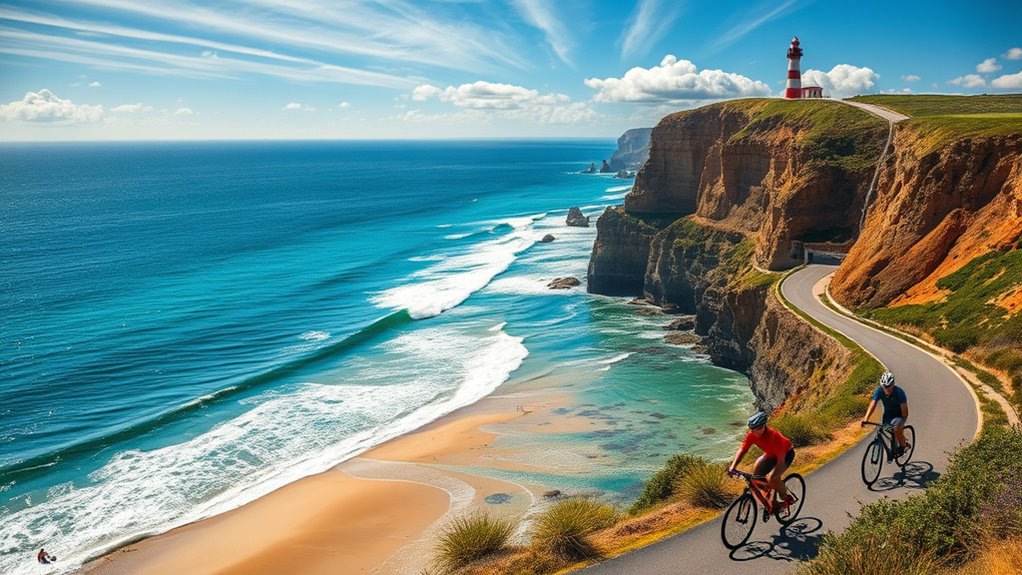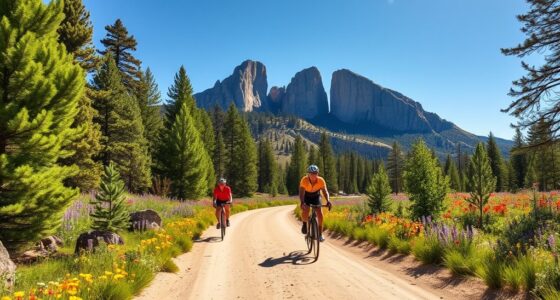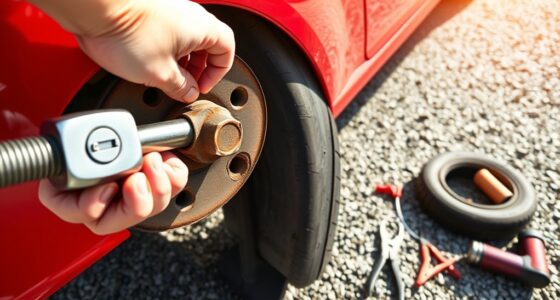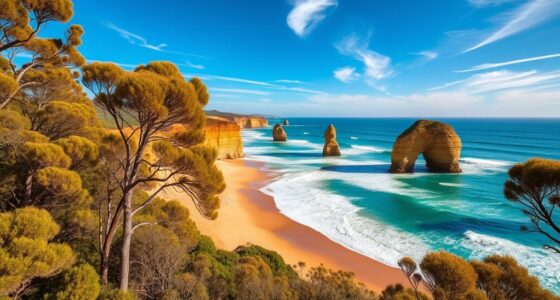Planning a coastal ride? Start by choosing scenic routes with manageable daily mileage of 100-150 miles. Equip your bike with bright lights, a comfortable saddle, and a repair kit for safety. Fuel up with balanced meals and hydration before and after cycling. Stay active by exploring local trails and engaging in the culture around you. You’ll want to discover hidden gems and perfect stops along the way. There’s so much more to guarantee an unforgettable adventure ahead!
Key Takeaways
- Map scenic coastal routes with manageable daily mileage of 100-150 miles for an enjoyable ride experience.
- Research accommodations in advance, especially during off-peak seasons, to ensure comfortable lodging.
- Prioritize safety with bright rear lights, essential supplies, and awareness of surroundings for a smooth ride.
- Explore local cuisine and cultural sites to enhance your journey and engage with the community.
- Focus on recovery nutrition with balanced meals and hydration post-ride to support overall performance.
Choosing the Perfect Route

When you’re planning your coastal ride, how do you choose the perfect route? Start by mapping out a route that goes through scenic areas, featuring stunning coastal views and lush old-growth forests.
Aim for manageable daily mileage of 100-150 miles to keep the ride enjoyable and not too exhausting. As you plan, research places to stay in advance, especially during off-peak seasons when accommodations may be limited.
Aim for daily mileage of 100-150 miles and research accommodations in advance for a comfortable coastal ride.
Consider potential traffic conditions, opting for quieter days, like Sundays, to enhance your experience. Don’t forget to account for elevation changes and challenging climbs, as these can impact your pacing and overall ride difficulty. Incorporating opportunities for physical activity and outdoor play will enrich your overall experience and well-being.
With careful planning, you’ll create a memorable coastal adventure!
Essential Gear for Your Ride

Having the right gear can make all the difference on your coastal ride. Start with a high-quality, comfortable bike saddle that minimizes discomfort during long hours on the bike.
Safety’s essential, so invest in a reliable helmet that meets safety standards, ensuring both protection and comfort.
Don’t forget a multi-tool and tire repair kit; being prepared for mechanical issues can save you from getting stranded on remote routes.
Hydration is key, so pack a hydration pack or water bottles to keep yourself refreshed, especially where water access may be limited.
Finally, layer your clothing with moisture-wicking materials to adapt to the coast’s changing weather, keeping you comfortable whether you’re heating up or cooling down. Additionally, consider implementing risk management strategies to ensure a safer and more enjoyable riding experience.
Nutrition for Endurance Cycling
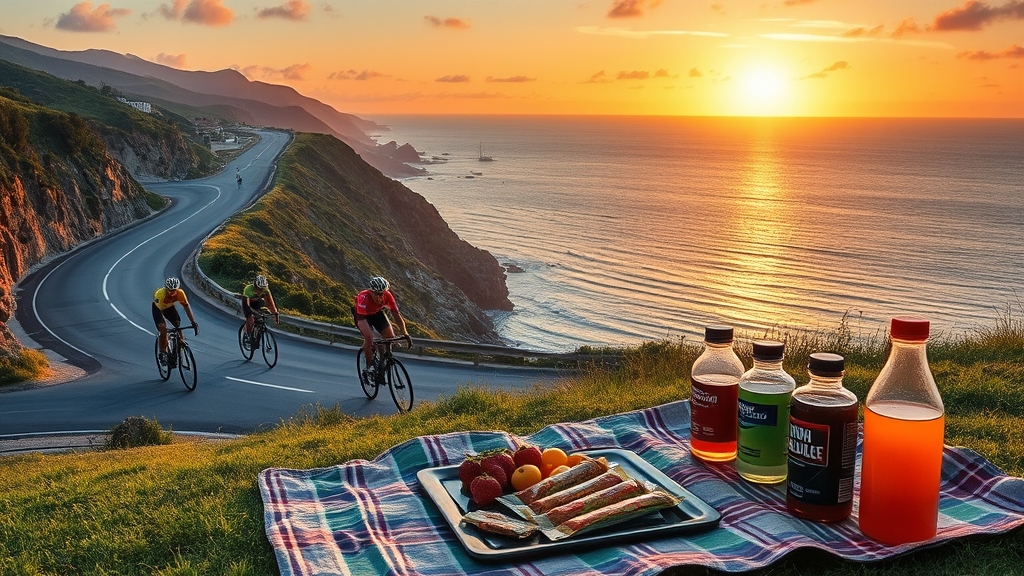
To conquer those long rides, you need to fuel your body right before, during, and after cycling.
Start with a balanced pre-ride meal and stay hydrated throughout to keep your energy levels up. Incorporating high-calorie breakfasts can provide the essential energy boost needed for endurance cycling.
Don’t forget about recovery nutrition; it’s key to repairing muscles and getting you ready for your next adventure.
Fueling Before Rides
Fueling properly before your ride is essential for maximizing performance and endurance. Aim to consume a balanced meal rich in complex carbohydrates, healthy fats, and protein 2-3 hours before you hit the road. This will optimize your energy levels throughout the session.
Don’t forget about hydration; drink at least 500-750 ml of water or an electrolyte drink in the hours leading up to your ride to stave off dehydration.
About 30-60 minutes before cycling, consider easily digestible snacks like bananas or energy bars for a quick energy boost. Steer clear of heavy or greasy foods, as they can slow digestion and cause discomfort.
Experiment with different foods during training to find what works best for your body on longer rides.
Hydration Strategies
Staying properly hydrated is essential for endurance cycling, especially during long rides. To optimize your hydration strategy, follow these tips:
- Drink 16-24 ounces of fluid per hour: Adjust based on heat and humidity levels.
- Incorporate electrolyte drinks: Choose options with sodium, potassium, and magnesium to maintain hydration and prevent cramps.
- Hydrate regularly: Don’t wait until you feel thirsty; sip water consistently to keep hydration levels high.
- Use hydration packs or bottles: These allow easy access to water while cycling, minimizing the need for frequent stops.
Also, monitor your urine color; light yellow means you’re well-hydrated, while darker shades indicate you need to drink more.
Stay hydrated for better performance on your coastal ride!
Recovery Nutrition Essentials
After a long coastal ride, what you eat and drink plays a significant role in how quickly you bounce back. To enhance recovery, consume a carbohydrate-rich meal or snack within 30 minutes post-ride to replenish glycogen stores.
Aim for a protein source, like a shake or lean meat, within two hours, targeting a 3:1 carbohydrate-to-protein ratio. Staying hydrated is essential, so rehydrate with water or electrolyte drinks to restore fluid balance.
Prioritize nutrient-dense foods such as fruits, vegetables, and whole grains for essential vitamins and minerals. Incorporate anti-inflammatory options like berries, nuts, and fatty fish to help reduce muscle soreness and expedite recovery. Including hydration support from foods with high water content, like celery, can further enhance your recovery.
With the right nutrition, you’ll stay energized and ready for your next adventure!
Staying Fit While Traveling

Traveling doesn’t mean you have to put your fitness on hold. You can easily incorporate local activities, enjoy a quick workout, and choose nutritious meals to stay on track. Additionally, recognizing the importance of hydration and nutrition can help you maintain your energy levels while on the go.
Exercise on the Go
- Biking or Hiking: Explore local trails or scenic routes.
- Walking Tours: Discover new places on foot while staying active.
- Bodyweight Workouts: Try 3 sets of 10 squats, push-ups, lunges, and reverse crunches wherever you are.
- Backpack Lifts: Use your luggage for added resistance during strength training.
Incorporating auditory feedback therapy techniques can further enhance your exercise routine by improving focus and mindfulness while staying fit.
Incorporate Local Activities
Incorporating local activities into your travel plans not only keeps you fit but also enriches your experience. Every destination offers unique opportunities for physical engagement, like biking, hiking, or walking tours that allow you to explore while exercising.
You can easily integrate bodyweight exercises, such as squats and push-ups, anywhere you go. Don’t miss out on cultural experiences that involve movement, like local dance classes or martial arts sessions, keeping you active while immersing yourself in the culture.
Prioritize outdoor activities in scenic spots, like hiking in national parks or cycling along coastal routes. By scheduling active excursions, such as guided bike tours or kayaking, you’ll maintain your fitness goals and enjoy every moment of your trip. Additionally, consider waterproofing your gear to ensure you stay dry and comfortable during outdoor adventures.
Maintain Healthy Eating
Maintaining a healthy diet during your travels can be a challenge, especially with tempting local cuisines at every turn. However, you can stay fit while enjoying your coastal ride by focusing on nutritious choices.
Here are some tips to help you maintain healthy eating:
- Prioritize healthy meals: Aim for real foods like fruits, vegetables, and lean proteins 80% of the time.
- Follow the “never two in a row” rule: Avoid consecutive unhealthy meals to keep your diet balanced.
- Consider intermittent fasting: Manage meal timing to prevent overeating, especially during long rides.
- Stay hydrated: Drink plenty of water and choose healthier alcohol options, like wine, when enjoying the local nightlife.
Incorporating whole foods into your meals can significantly enhance your nutritional intake.
With these strategies, you can navigate any road conditions while maintaining your health.
Incorporating Local Culture
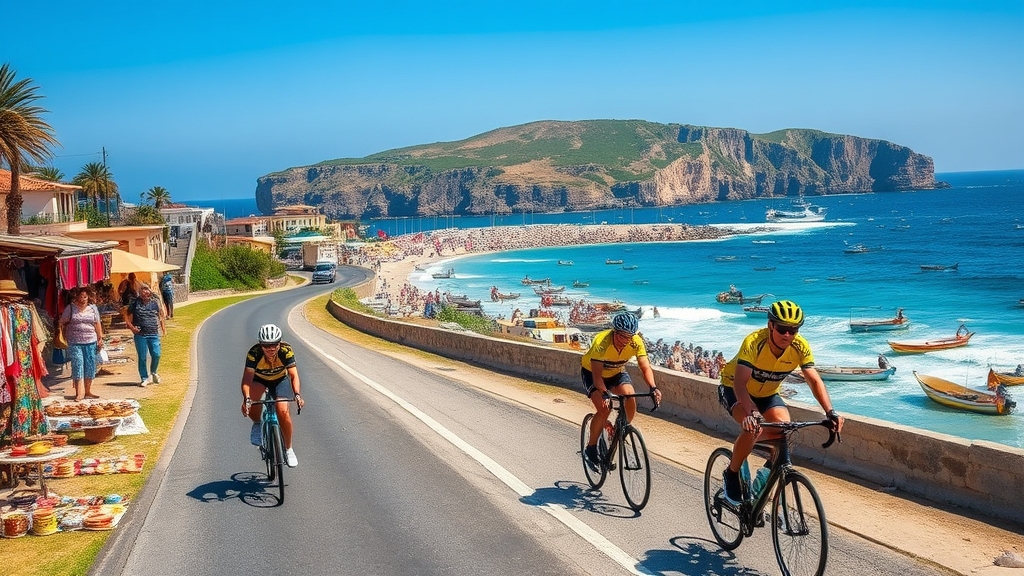
As you journey along the coast, immersing yourself in local culture can transform your ride into a memorable adventure.
Seek out regional cuisine by stopping at charming eateries and food trucks, where you can savor traditional dishes that tell a story of the area.
Attend local festivals or events to engage with communities and experience authentic cultural traditions firsthand.
Don’t miss the chance to visit historical sites that reflect the region’s heritage.
Take time to interact with local artists and craftsmen at markets or galleries; their work offers insight into the area’s artistic expressions.
If you’re up for it, join guided tours led by locals for unique perspectives and fascinating stories that you won’t find in guidebooks. Additionally, indulge in local seafood festivals that highlight the region’s culinary offerings and sustainable practices.
Planning for Safety on the Road

While planning your coastal ride, prioritizing safety on the road is essential for a smooth and enjoyable experience. Here are some key tips to keep in mind:
- Ensure visibility: Use bright rear lights on your bike, especially on small roads shared with vehicles.
- Plan your route: Consider traffic patterns and aim for riding on Sundays to reduce vehicle interaction.
- Stay aware: Be mindful of your surroundings and potential hazards, particularly on busy roads or challenging sections, like after Ventura.
- Carry essential supplies: Bring water, snacks, and a basic repair kit, as certain areas may have limited refueling options, particularly on long stretches.
Enjoying Scenic Stops Along the Way
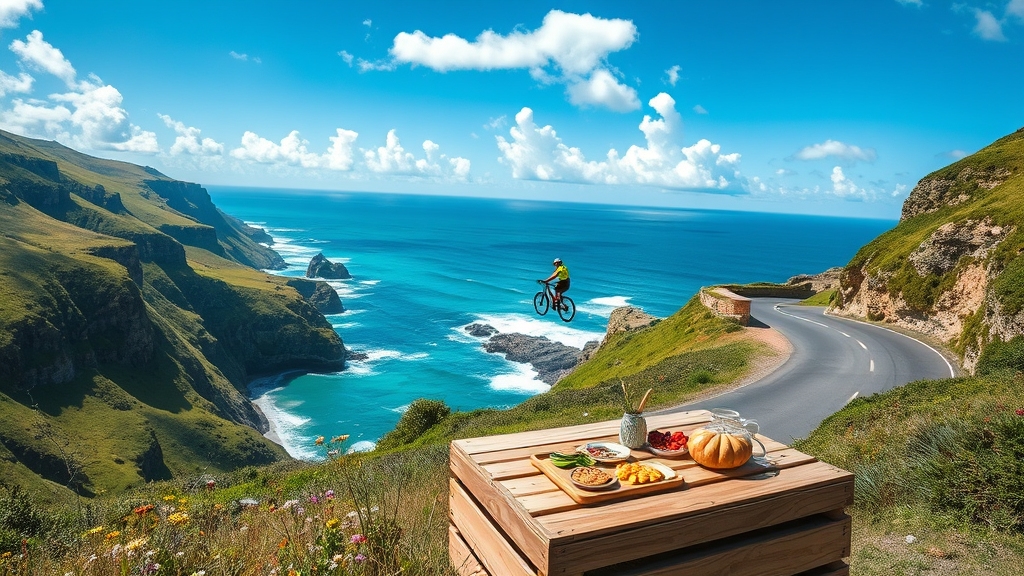
What’s a coastal ride without a few scenic stops to enrich your journey?
As you cruise along, take a break in charming towns like Ferndale, CA, where Victorian architecture creates a picturesque backdrop.
Take a leisurely pause in Ferndale, CA, where charming Victorian architecture sets a stunning scene for your journey.
Don’t miss the Avenue of the Giants, with its towering redwoods offering stunning views perfect for photos.
Keep an eye out for local dining options in Mendocino, CA, where cozy coffee shops and cafes invite you to relax and recharge.
Indulge your taste buds at Two Fish Bakery, a delightful stop for local treats while enjoying ocean views.
Prioritize scenic detours to hidden gems like Sani Beach or historical forts to add unique cultural experiences to your ride.
Embrace the journey, and let these moments linger! Additionally, consider how color accuracy can enhance your home cinema projector experience when you return from your ride.
Post-Ride Recovery Tips
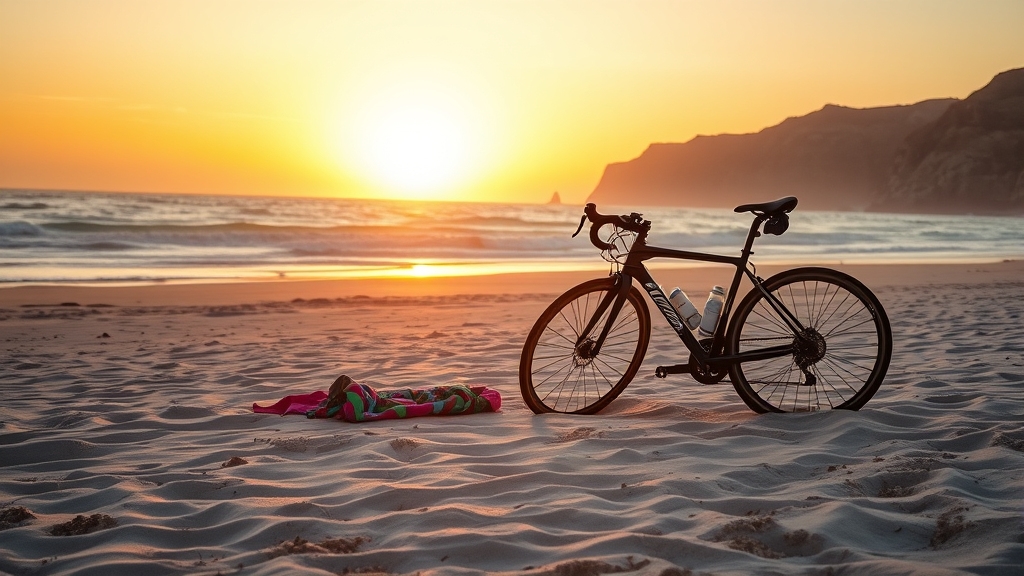
After an exhilarating coastal ride, it’s crucial to focus on your recovery to guarantee your body bounces back.
Here are four key tips to aid your muscle recovery:
- Hydration: Drink 16-24 ounces of water for every hour spent cycling to replenish lost fluids.
- Post-Ride Meal: Consume a meal rich in carbohydrates and protein within 30 minutes; aim for a 3:1 ratio to optimize muscle recovery.
- Stretching: Spend 10-15 minutes stretching major muscle groups to improve flexibility and reduce soreness.
- Rest: Prioritize quality sleep; aim for 7-9 hours to support muscle repair and overall recovery.
Incorporating these tips will help you feel refreshed and ready for your next ride!
Frequently Asked Questions
How Difficult Is the Coast to Coast Bike Ride?
The coast-to-coast bike ride can be quite challenging.
You’ll face significant elevation gains, especially on routes like San Francisco to Mexico, which can involve climbing over 10,000 feet. Daily distances often range from 110 to 150 miles, demanding strong endurance and pacing.
Limited refueling points can also complicate things, particularly on certain days. Plus, you’ll need to stay alert for traffic, especially in busy areas like Los Angeles, and adapt to varying weather conditions.
How Long Does It Take to Bike the Oregon Coast?
Biking the Oregon Coast feels like riding through a breathtaking postcard, where each mile reveals stunning vistas.
It typically takes you about 5 to 7 days to complete the journey, depending on how far you choose to pedal each day. Covering approximately 363 miles from Astoria to Brookings, you’ll want to aim for 50 to 75 miles daily, allowing time to explore charming coastal towns and soak in the beautiful scenery.
How Long Is the Pacific Coast Bike Route?
The Pacific Coast Bike Route stretches about 1,850 miles from Canada to Mexico.
As you ride along, you’ll experience breathtaking views of the Pacific Ocean and diverse landscapes.
While the entire route can take you anywhere from 2 to 4 weeks to complete, it all depends on your pace and the number of stops you choose to make.
Make sure to plan ahead for those scenic spots you won’t want to miss!
How Many Miles to Bike From Coast to Coast?
Biking coast to coast typically ranges from about 2,000 to 3,000 miles, depending on the route you choose.
If you’re looking for a more scenic experience, routes like the TransAmerica Trail span around 4,200 miles.
Consider planning for daily mileage of 60 to 100 miles, which means your journey could take anywhere from 20 to 50 days.
Don’t forget, elevation changes and terrain will affect both distance and difficulty, so prepare accordingly!
Conclusion
As you pedal along the coast, remember that this journey isn’t just about the destination; it’s about the memories you create. Channel your inner adventurer, like those pioneers who roamed the wild, and embrace every moment. Soak in the salty air, indulge in local flavors, and connect with fellow travelers. With the right preparation and a spirit of exploration, your coastal ride will be an unforgettable chapter in your story. Now, get out there and enjoy the ride!
